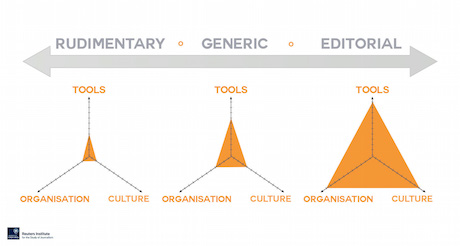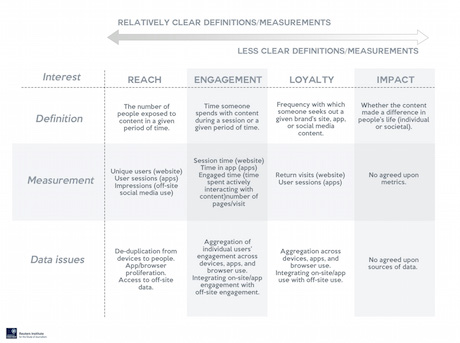
Publishers are using analytics to inform how they produce and distribute stories, but most of them are still struggling to transition from a basic or generic use of audience data to an approach tailored to their organisation's goals.
This is one of the main findings from 'Editorial analytics: How news media are developing and using audience data and metrics', a new report published today by the Reuters Institute for the Study of Journalism at Oxford University (RISJ), authored by Federica Cherubini, media consultant, and Rasmus Kleis Nielsen, director of research, RISJ.
Cherubini, the study's lead author, interviewed more than 30 audience development editors and newsroom analysts across Europe and the US to highlight best practices, recommendations and challenges in using editorial analytics.
Here are some of the main findings from the report, grouped into four categories:
Key principles behind editorial analytics
Most news organisations analysed in the paper, both legacy media players and digital-only outlets, recognised the importance of analytics and seemed to agree that these should play an informative rather than leading role in the newsroom.
The report highlighted that while there is no one 'God metric' for journalism as a whole, a favourable approach for publishers should be underpinned by three elements, alongside the actual data: technological tools, both mainstream and built in-house; a company's organisational structure; and a newsroom culture open to incorporating analytics for longer term development.
It also identified that some outlets have successfully tailored their approach to analytics according to their goals and business models, which can vary from editorial impact, to higher reach or converting readers into paying subscribers.
The use of analytics in European and North American newsrooms
Chapter two of the report analysed a number of news organisations operating in different markets to find similarities and differences in how they have incorporated analytics into their editorial workflows.
Three types of analytics were identified:
- rudimentary – offers a certain amount of data, but lacks cohesiveness with newsroom organisation and culture;
- generic – multiple analytics tools are used, but the newsroom's structure and mindset are optimised for short-term results;
- editorial – bespoke tools, supported by an organisation and culture focused on short-term and long-term data-informed decisions, and flexible to evolve as the industry changes
Between themselves, the four organisations ticked the three boxes of tools, organisation and culture through their use of in-house analytics platforms, tailored metrics and dedicated audience teams.
Elsewhere in continental Europe, the study found audience development teams or even audience editors were not that common, with analytics often overseen ad-hoc or performed as an additional task by existing members of the newsroom.
An example of this is Ze.tt, a digital-only spin-off from the publisher of German newspaper Die Zeit and Zeit Online launched in July 2015, which currently uses data to monitor and grow their audience, and Dutch crowdfunding platform De Correspondent, where analytics are mainly used to track newsletter signups and their rate of conversion to subscriptions.
Anonymously, several interviewees in the report expressed a concern that their organisations have adopted analytics, but have yet to tailor their approaches for interpreting the data in a relevant and insightful manner.
Cherubini and Nielsen suggested this was likely caused by the organisational structure of the company, a lower pressure faced by these outlets in competing for global audiences and a delay in adopting the relevant technology and terminology, which are often developed and marketed in the US and UK first.
Striking the balance between technology, organisation and culture
"Analytics are about technology and data, but not only technology and data," Cherubini and Nielsen pointed out in the report.
They outlined a model where tools, organisation and culture are the three dimensions of a triangle designed to assess news outlets' capability to figure out the best analytics approach to suit them and their resources.
In this scenario, the tools are represented by the technology used in the newsroom, including data sources, software, interfaces and internal and external analytics platforms.

The organisational aspect refers to a structured process of using analytics, assigned to experienced staff members or dedicated teams working with the rest of the newsroom.
The third dimension, culture, was identified as an overall attitude of editorial staff to "routinely and willingly use analytics and data as part of their decision-making".
While many audience teams often provide performance data to the newsroom through daily or regular emails, or by implementing short-term strategies to optimise content, "these are numbers without meaning and without consequences and rarely inform editorial decision-making".
"Developing a ‘culture of data’ in the newsroom is about making sure that journalists and editors who are not part of the audience team are given access to data that are relevant to them, know why – and agree that – this data is relevant for them, and know how to act on it," Cherubini and Nielsen said in the report.
Challenges and opportunities in editorial analytics
Looking ahead, two types of challenges were defined in the report, according to how far publishers are from transitioning from rudimentary or generic analytics to editorial use.
News organisations that are still in the early days of the process should look at: defining metrics for measuring success; adapting them to different platforms and linking them to specific demographics; putting the numbers into a wider context; and finding the balance between analytics, editorial aims and the organisation's business goals.

News outlets that have already identified and implemented some of the best practices in editorial analytics should focus on using data to connect readers' news consumption across devices, mediums and platforms, as well as continuing to expand on their effort to define and measure editorial priorities such as the impact of their journalism.
"Editorial analytics are an evolving phenomenon.
"It is not about identifying a few standard tricks to increase audience reach or engagement, but about developing a process where quantitative evidence supplements more qualitative editorial expertise and enables continuous evaluation of performance and experiments to improve workflows and results," Cherubini and Nielsen pointed out.
Read the full report here.
Free daily newsletter
If you like our news and feature articles, you can sign up to receive our free daily (Mon-Fri) email newsletter (mobile friendly).
Related articles
- Journalism.co.uk reader responses: what we have learned so far from our audience survey
- Journalism must update its mission to survive
- RISJ Digital News Report 2024: User needs with Vogue and The Conversation
- RISJ Digital News Report 2024: Three essential points for your newsroom
- RISJ Digital News Report 2024: Five trends to watch in the UK









